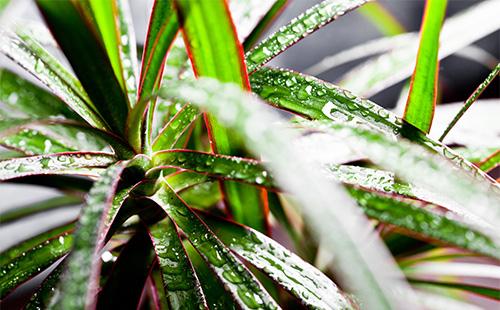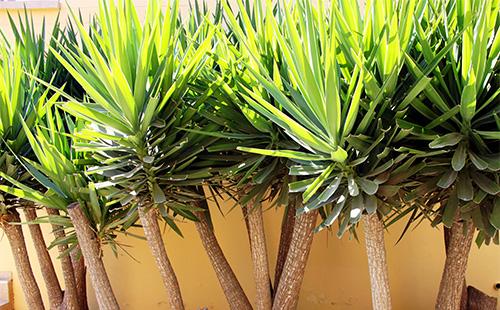The content of the article
Bordered by dracaena calmly tolerates light shading, it is therefore suitable for growing not only in apartments, but also in offices. It is believed that dracaena has a positive effect on the indoor microclimate - it moisturizes the air and absorbs toxic substances.
Description and Features
Refers to evergreen trees. The habitat is Madagascar, Reunion Island. Under natural conditions, it reaches 5 m. The branching is weak, the stems are straight, bare with time. Scars remain in place of the fallen leaves, forming a raised surface of the trunk.
The leaves are long, narrow, coarse, bundled. The tips are pointed. The length of the leaves with good care reaches 70 cm. The veins are parallel, connected at the tip of the leaf. Young leaves grow up. As they grow, they lower to the sides and down under their own weight.
Sometimes fringed dracaena is called a dragon tree for a similar structure and red-green color. The name “fringed” appeared due to the red and violet hue of the border around the edge of the leaves.
Blooms marginata dracaena is very rare. Margarita flowers are not particularly decorative - small, white or greenish. The smell is very heavy, fragrant. Because of the aroma, they are taken out onto the balcony during flowering.
Post-purchase Content
Caring for dracaena marginata after purchase is to create favorable conditions for adaptation. The flower is placed in a non-hot, well-ventilated room separately from other indoor plants. During the adaptation period, they are protected from direct sun, watered moderately, only for easy moistening of the soil.
The dry content helps to detect undetected when buying insects, take timely measures. The quarantine lasts two weeks, after which the dracaena is placed in a constant place, taking into account its requirements for lighting and temperature.
After quarantine, the dracaena is transplanted. A pot of suitable size and a balanced soil composition are selected. Care for dracaena marginata after transplant is gentle. Top dressing for a month and a half is limited, watered in a timely manner, avoiding waterlogging and drying out of the soil.
Care for Dracaena Marginata: what to consider
Growing dracaena marginata at home is not considered difficult. In adverse conditions of detention it loses decorativeness, resistance to viral and fungal diseases. Experienced growers recommend adhering to the basic parameters of creating a favorable microclimate and care.
- Lighting. Dracaena marginata is afraid of direct sunlight - she prefers not too bright diffused light. The exception is variegated hybrid varieties - to maintain a bright color, they need bright lighting. Even young plants are not placed on the windows. They are placed in the back of the room opposite the windows.Fully grows under artificial lighting. In the summer, you can take it to the garden or balcony, providing protection from the sun. In winter, they organize artificial lighting.
- Temperature. Heat-loving plant. In winter, the temperature should not fall below 16 ° C. In the summer, it adapts to any temperature, easily tolerates heat.
- Humidity. It adapts easily to dry air, but decorativeness may decrease - the tips of the leaves dry. Systematic spraying with clean, warm water from a fine atomizer is recommended. Dry tips are cut without injuring living tissue, the tub is placed in a tray with wet expanded clay, hydrogel or sphagnum. It is forbidden to put near heating appliances. Gratefully reacts to periodic bathing under a warm shower. In large specimens, you can wipe the leaves with a damp soft cloth.
- Watering. It is recommended to water margeninate dracaena often, but in moderation. The soil should always remain slightly moist. Drying is done about once a month - they allow the soil to dry for a few centimeters. Excess moisture is worse than its lack. In winter, the frequency and abundance of irrigation is reduced, at a temperature below 20 ° C they are not sprayed.
- Top dressing. Fertilizers are applied almost year-round. In the period of active growth, fertilize twice a month, in the winter it is enough to feed once a month, reducing the concentration of the drug by half. Top dressing is stopped at a temperature below 18 ° C. It is preferable to use special fertilizers for dracaena or palm trees.
- The soil. Soil is taken ready, designed specifically for palm trees and dracaena. For loosening, add crumb brick, for the prevention of rotting of the roots - crushed charcoal. Be sure to provide a drainage layer.
- Transfer. It is enough to transplant margenata dracaena once every two to three years. Young plants in the stage of active growth are transplanted annually. The volume of the pot does not increase much - each time by 3 cm in diameter. The root system is fragile - preference is given to the transshipment method. Large, adult dracaena in outdoor tubs can not be transplanted - enough to replace the topsoil once a year.
- Pruning. For the formation, achievement and preservation of maximum decorativeness, it is recommended to trim margeninate dracaena. In a young, but sufficiently overgrown plant, the top is cut off. The place of cut is treated with carbon powder, covered with a plastic bag. Some time after pruning, the lateral sleeping buds will awaken and let out vertically growing young shoots. Instead of one trunk, three to five shoots will appear. After signs of growth appear, the packet is removed. The top is rooted separately to obtain another plant.

Breeding methods
Features Only vegetative propagation of dracaena marginate is practiced. It is not possible to get seeds on your own; growing from store seeds takes a very long time. Therefore, only propagation by apical or stem cuttings is used. The optimal period for cuttings is spring or the very beginning of summer.
Action algorithm
- From the mother plant, the apical or stem cuttings are cut. Slices are immediately treated with carbon powder.
- The cuttings are dried for at least two hours in a well-ventilated, shaded place.
- The lower part of the handle is treated with a root stimulant and placed in light soil with a predominance of sand.
- The container is covered with a plastic bag or jar to maintain stable humidity and temperature. Its level in the greenhouse should be kept within 25-30 ˚С.
- The package is removed from time to time, the greenhouse is ventilated, excess condensate is removed, the substrate is moistened.
- After the roots appear, the shelter is removed, the seedling is carefully transplanted into a suitable pot.
Frequent diseases
The main danger to dracaena is infectious diseases. With excessive watering, it can be affected by rot. In favorable conditions of detention rarely gets sick. The most common diseases of dracaena marginata are shown in the table.
Table - Diseases of marginata dracaena
| Disease name | Characteristic signs | Treatment methods |
|---|---|---|
| Heterosporosis | - Light brown spots bordered by a dark rim; - the shape of the spots is elongated; - olive plaque | - Immediate treatment with fungicides “Fundazol” “Fitosporin-M” |
| Phyloscystosis | - Faded brown spots bordered by a yellowish-green rim; - irregular shape of spots; - small black dots on the leaves | - Repeated spraying with systemic fungicides |
| Tomato Spotted Wilt Virus | - The formation of spots with dark lines; - growth inhibition; - deformation of young foliage | - Cutting and destruction of diseased parts; - repeated treatment with fungicides |
| Alternariosis | - Fungus; - dry round pale brown spots with a bright dot; - blackening of the center of the spot | - Treatment with fungicides - "Fundazol", "Fitosporin-M", "Topaz" |
Common pests
Pests often attack weakened plants. Insects quickly multiply in dry air. Information on the most common pests is collected in the table.
Table - Pests of marginata dracaena
| Insect name | Characteristic signs | Methods of struggle |
|---|---|---|
| Shield | - Brown plaques on the surface of stems and leaves; - leaves dry and crumble | - Treatment of lesions with a swab dipped in a soap or alcohol solution; - spraying with Actellik |
| Thrips | - Light dots on apical leaves; - silver shine; - the leaves are dry | - Repeated spraying with “Inta-Vir”, “Decis”, “Fitoverm” preparations |
| Aphid | - The leaves turn yellow; - twisting, deformation of growth points; - falling of leaves; - sticky coating | - Bathing with soapy water; - spraying with means of "Derris", "Fitoverm" or tobacco dust infusion |
| Spider mite | - Braiding the plant with a thin cobweb; - the appearance of first yellow, then dark spots | - Increase in air humidity; - spraying with acaricides; - washing with soapy water |
| Mealybug | - White plaque; - lumps of "cotton wool" in the axils of the leaves | - Wipe with alcohol or soap; - insecticide treatment |

The main problems of growing
Errors in care, inappropriate conditions of detention often lead to a partial loss of decorativeness. Leaves can dry, fall, change color. Common problems and their possible causes are shown in the table.
Table - Problems in the cultivation of dracaena marginata
| Problem | Probable reasons |
|---|---|
| Brown edges, drying out the ends of the leaves | - Low humidity; - cold drafts |
| Drying shoots, falling leaves | - Strong hypothermia; - excessive moisture in the soil; - root decay |
| Blackening of the tips of the leaves, weak growth | - lack of nutrients; - heavy soil |
| Leaf rot from the top | - Bacteriosis; - lack of light; - regular waterlogging; - cold content; - poor air ventilation |
| Wet, dying brown spots over time | - Sunburn |
| Leaves are dull, lifeless, dangling | - Too cold; - frostbite |
| Blackening and drying of young leaves | - The accumulation of salts in the soil; - overdose of fertilizers; - prolonged lack of transplantation |
All types of dracaena are highly decorative, very popular among flower growers.Since it is not very difficult to take care of margenata dracaena, it can be recommended for landscaping not only apartments, but also office premises.

